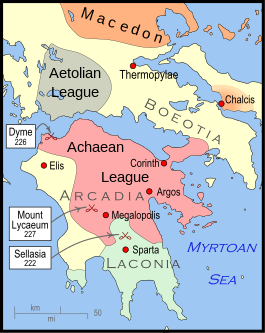
Back الحرب الكليومينية Arabic Клеоменова война Bulgarian Kleomenischer Krieg German Κλεομένειος Πόλεμος Greek Kleomenea milito Esperanto Guerra de Cleómenes Spanish Guerre de Cléomène French Guerra de Cleómenes Galician המלחמה הקלאומנית HE Kleomenészi háború Hungarian
| Cleomenean War | |||||||||
|---|---|---|---|---|---|---|---|---|---|
 Greece at around the time of the Cleomenean War | |||||||||
| |||||||||
| Belligerents | |||||||||
|
Sparta, Elis |
Achaean League, Macedonia | ||||||||
| Commanders and leaders | |||||||||
| Cleomenes III |
Aratus, Antigonus III Doson | ||||||||
| Strength | |||||||||
| ~20,000 (at largest muster) | ~30,000 (at largest muster) | ||||||||
The Cleomenean War[3] (229/228–222 BC) was fought between Sparta and the Achaean League for the control of the Peloponnese. Under the leadership of king Cleomenes III, Sparta initially had the upper hand, which forced the Achaean League to call for help the Macedonian king Antigonos Doson, who decisively defeated Cleomenes in the battle of Sellasia in 222.
In 235 BC, Cleomenes III (r. 235–222 BC) ascended the throne of Sparta and began a program of reform aimed at restoring traditional Spartan discipline while weakening the influence of the ephors, elected officials who, though sworn to uphold the rule of Sparta's kings, had by the time of Cleomenes come to wield extraordinary political power in the Spartan system. When, in 229 BC, the ephors sent Cleomenes to seize a town on the border with Megalopolis, the Achaeans declared war. Cleomenes responded by ravaging Achaea. At Mount Lycaeum he defeated an army under Aratus of Sicyon, the strategos of the Achaean League, that had been sent to attack Elis, and then routed a second army near Megalopolis.
In quick succession, Cleomenes cleared the cities of Arcadia of their Achaean garrisons, before crushing another Achaean force at Dyme. Facing Spartan domination, Aratus was forced to turn to Antigonus III Doson (r. 229–221 BC) of Macedon. In return for Macedonian assistance, the Achaeans were obliged to surrender the citadel overlooking Corinth to Antigonus. Cleomenes eventually invaded Achaea, seizing control of Corinth and Argos, but was forced to retreat to Laconia when Antigonus arrived in the Peloponnese. Cleomenes fought the Achaeans and the Macedonians at Sellasia, where the Spartans were routed. He then fled to the court of his ally, Ptolemy III of Egypt (r. 246–222 BC), where he ultimately committed suicide in the wake of a failed revolt against the new Pharaoh, Ptolemy IV (r. 221–205 BC).
- ^ Hammond & Walbank 2001, p. 305.
- ^ Habicht 1997, p. 175; Hammond & Walbank 2001, p. 353.
- ^ Polybius. The Rise of the Roman Empire, 2.46.